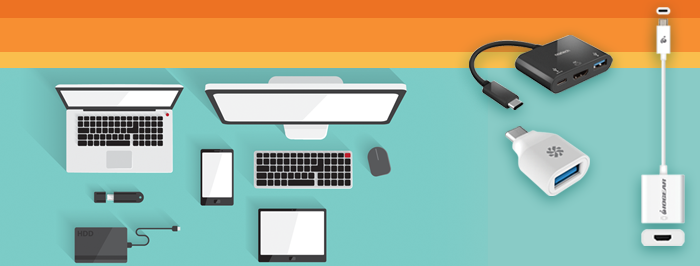
The Need for Something New
It seems simple enough. As computer technology became a mainstream fixture of the consumer landscape, connections between devices should have been a cinch. Yet for the last 25 years, PC owners have known the annoyance of needing different cables for different peripherals. That’s where USB C comes in. But what is USB C?
The flat, rectangular type-A connector may come to mind first—it’s the standard receptacle on a PC (and Blu-ray players, video game consoles, etc.). The much more square-shaped type-B connector is heavily associated with printers and is also used to connect devices like hard drives to a computer for data transfer purposes.
But then there are the different sizes. Besides standard connectors, there’s Mini-USB for smaller devices. Then along came Micro-USB as ports got even smaller. Both of these variants work with devices like cellular phones and digital cameras, and both are USB-B. (The USB-A end remains the same.)
And that’s not to mention the different versions of USB, including Low Speed (1.0), High Speed (2.0), SuperSpeed (3.0), and more.
In short, while USB may stand for Universal Serial Bus, there has not been a single universal cable…
Until now.
What is USB C?
The user will immediately notice a difference in the shape of the USB C. The connector is thicker and shaped more like an oval, bearing some similarity to a Micro-USB connector in size.
More importantly, USB C is defined by reversible plug orientation. An article in PC Mag explains it well:
“Like Lightning… the USB C connector has no up or down orientation. Line up the connector properly, and you don’t have to flip it to plug it in. The cables also have the same connector on both ends, so you don’t have to figure out which end goes where, which has not been the case with all the USB cables we’ve been using for the past 20 years.”
In other words, consumers don’t have to worry about awkward fumbling with cable connectors and ports!
But that’s not the only thing that makes it such a significant change from its predecessors. It’s also faster—much faster—in terms of data signaling. The latest protocol is USB 3.2, which supports speeds of up to 2.5GB/s (Gigabytes per second). Compare this to USB 3.0, whose rate was only 5Mbps.
With its Thunderbolt 3 capabilities, USB C doesn’t require an external power source to function. It allows bi-directional power, eliminating the need for power bricks and other proprietary power devices.
Thus, the industry has adopted a connection standard that’s more convenient and more efficient than what came before it. In fact, previous types are mostly obsolete. In fact, you’d be hard-pressed to find a notebook or laptop with a USB a or B port at all.
Where Are We Now?
Two words: sales opportunities.
If USB C isn’t quite the industry standard yet, it’s rapidly getting there. According to IHS Markit, USB C shipments will reach nearly 5 billion by 2021, which will account for near-global of adoption of USB C type devices.
Consider what this might mean in terms of products. “Charge and sync” USB C to USB-A cables let users bridge the past and present at maximum speed. Typically measuring somewhere between 6 inches and 6 feet, these cables come from brands like iLuv and Naztech.
Meanwhile, MacBook owners in need of more than the one USB C port provided by Apple may be in the market for a product like the Kanex USB C to USB Adapter.
The Takeaway
When prepping your sales team to sell these valuable accessories, here are the key points to keep in mind:
- Easier to use
- Universal usage
- Simplified power systems
To learn more about these and other great SKUs from the emerging world of USB C, don’t hesitate to make a connection with Petra! Visit our website or contact one of our sales representatives today.
